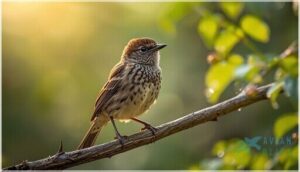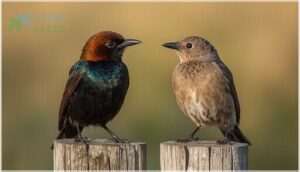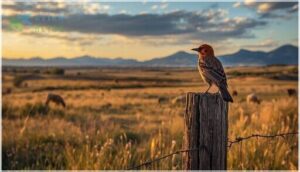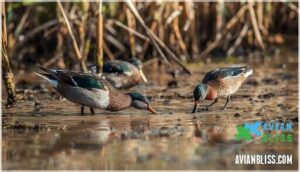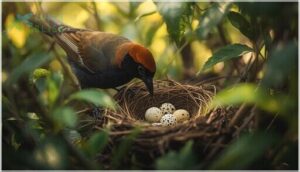This site is supported by our readers. We may earn a commission, at no cost to you, if you purchase through links.
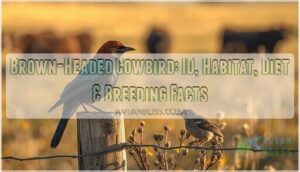
The male’s glossy black body and chocolate-brown head make identification straightforward, while the female’s subtle brown plumage helps her approach host nests undetected.
Found across nearly all of North America, from coastal regions to inland prairies, brown-headed cowbirds have adapted to thrive wherever livestock graze and open ground provides foraging opportunities.
Their reproductive tactics have earned them both scientific fascination and conservation concern, as their parasitic breeding affects over 220 host species and threatens vulnerable songbird populations.
Table Of Contents
- Key Takeaways
- Brown-Headed Cowbird Identification
- Habitat and Range of Brown-Headed Cowbirds
- Diet and Foraging Behavior
- Breeding Habits and Brood Parasitism
- Ecological Impact and Conservation Efforts
- Frequently Asked Questions (FAQs)
- Are Brown-headed Cowbirds good?
- Why is the Brown-headed Cowbird considered a parasite?
- Why are Brown-headed Cowbirds a threat?
- Should I remove Brown-headed Cowbird eggs?
- How do cowbirds interact with their biological offspring?
- What is the cowbirds call and song like?
- When do cowbirds typically migrate and return?
- How many eggs can a female cowbird lay?
- What conservation status do brown-headed cowbirds have?
- How long do brown-headed cowbirds live?
- Conclusion
Key Takeaways
- Brown-headed cowbirds practice brood parasitism across over 220 host species, laying up to 40 eggs per season in other birds’ nests and never raising their own young, which has pushed vulnerable songbirds like Kirtland’s warbler and least Bell’s vireo toward critical population declines.
- The species thrives in fragmented landscapes near livestock operations, where 98% of observations show direct cattle association, and their range has expanded dramatically from historic Great Plains origins as agriculture opened new territories across North America.
- Cowbird chicks hatch early and outcompete host nestlings for food, reducing fledgling success in parasitized nests by up to 68%, while host species that reject cowbird eggs face 56% predation rates, creating a devastating cycle that reshapes entire songbird communities.
- Conservation efforts combining targeted cowbird trapping with habitat restoration have achieved dramatic recovery in some endangered species—boosting least Bell’s vireo populations from under 300 pairs to over 2,000—though climate change projections suggest parasitism rates could increase 20% in fragmented habitats, complicating future protection strategies.
Brown-Headed Cowbird Identification
Spotting a brown-headed cowbird in the field becomes much easier once you know what to look for. These medium-sized songbirds show clear differences between males, females, and juveniles that help distinguish them from similar species.
Let’s break down the key physical traits that make identification straightforward.
Male and Female Physical Differences
Sexual dimorphism in the brown-headed cowbird (Molothrus ater) is striking. Males display glossy black plumage with a contrasting brown head, measuring 19–22 cm long and weighing 42–50 g. Females are smaller—16–20 cm—with dull brown coloration and faint streaking. Both sexes share a short, conical bill, though size differences and color patterns make identifying this bird species straightforward in the field.
The brown-headed cowbird’s unique characteristics can be further understood by studying their ecological niche.
Juvenile Appearance and Size
Young brownheaded cowbirds look entirely different from adults. Juveniles display heavily streaked brown underparts and pale edgings on back feathers—warmer and more patterned than adult females. You’ll spot these fledgling cowbirds from June through September, measuring 16–22 cm with thick, conical bills.
Nestlings grow fast, nearly doubling their weight between day five and ten post-hatching, reaching 30–50 grams at fledging. The brown-headed cowbirds’ development is influenced by their habitat and diet.
Distinctive Colors and Bill Shape
As juveniles mature, you’ll notice the male’s iridescence effects transform into glossy black plumage paired with a chocolate-brown head—visual cues that set this bird species apart. Females wear uniform grayish-brown across their bodies.
Both sexes share a distinctive beak structure: short, thick, and finch-like, ideal for cracking seeds.
These plumage patterns remain consistent across regions, making species identification straightforward in avian ecology studies.
Habitat and Range of Brown-Headed Cowbirds
Brown-headed cowbirds roam across nearly every corner of North America, from coastal regions to inland prairies. Their success stems from an impressive ability to adapt to diverse landscapes—wherever cattle graze or open ground provides easy foraging, you’ll likely find them.
Understanding where these birds live and how they move throughout the year reveals much about their striking spread and persistence.
Geographic Distribution Across North America
You’ll find brown-headed cowbirds across the entire United States, most of Canada, and northern Mexico, with their historic core centered in the Great Plains. This bird species began its regional expansion during the 19th and 20th centuries, spreading eastward and westward as habitat fragmentation from agriculture opened new territories.
Migration patterns vary by latitude—northern populations move south for winter, while southern residents often stay year-round, creating complex population dynamics across their geographic range.
Preferred Habitats and Landscapes
You’ll spot brown-headed cowbirds in open grasslands, prairies, and woodland edges where habitat fragmentation has created a patchwork of feeding and nesting opportunities. Edge effects matter—parasitism rates climb near forest openings, while interior forests remain largely avoided.
Urban landscapes and agricultural areas with scattered trees offer ideal conditions, combining foraging grounds with elevated perches for nest surveillance. Landscape heterogeneity drives their success across fragmented habitats.
Association With Livestock and Human Activity
Throughout their range, cowbirds depend almost entirely on cattle and horses for feeding opportunities—98% of observations in New Mexico documented this association. Livestock dependence shapes their daily movements and habitat selection in profound ways:
- Cowbirds abandon pastures immediately when cattle are removed
- Females commute up to 7.7 km from breeding sites to reach active grazing areas
- Agricultural impacts include higher local densities near feedlots and farmland edges
- Grazing patterns directly influence parasitism intensity on songbird hosts
Seasonal Movements and Migration Patterns
During the breeding season, you’ll find cowbirds widely dispersed across North America, but migration routes shift dramatically come autumn. Northern populations move south to Texas, Louisiana, and Mexico—some traveling over 530 miles.
Winter roosts can hold millions of blackbirds together. Climate adaptation now allows some individuals to winter farther north than historically documented, reshaping traditional wintering habits and flocking behavior patterns.
Diet and Foraging Behavior
Brown-headed cowbirds aren’t picky eaters—they’ve adapted to find food wherever they go, whether that’s trailing behind livestock or foraging across open fields. Their diet shifts with the seasons, balancing between protein-rich insects and energy-packed seeds depending on what’s available.
You’ll often spot them feeding in groups, using simple but effective methods to gather their meals throughout the year.
Primary Foods: Seeds and Insects
If you’re wondering what keeps cowbirds thriving across the continent, the answer lies in their flexible menu. Seeds form the backbone of their diet and foraging, with corn, millet, and grass varieties frequently consumed at seed feeders and birdseed feeders.
Insect intake complements this, especially grasshoppers and beetles stirred up by livestock—making the cowbird diet and feeding strategy remarkably adaptable and opportunistic.
Seasonal Variations in Diet
Like many songbirds, cowbirds shift their diet and foraging patterns with the seasons. During summer foraging, insect prey—especially grasshoppers and beetles—makes up roughly half their intake, supporting reproduction and nesting habits.
Winter feeding flips the script: seed consumption climbs above 90%, with corn dominating northern diets.
These dietary adaptations reflect shifting availability and energy demands, illustrating key principles of bird behavior and avian ecology and conservation across the cowbird diet and feeding spectrum.
Foraging Methods and Social Feeding
You’ll often spot cowbirds walking the ground in tight flocks, where flock dynamics dictate who eats best. Central birds peck 10–14 times per minute—twice the rate of edge members stuck on lookout.
These foraging strategies rely on social learning and group coordination: when one bird finds food, others converge fast. Near livestock or bird feeders stocked with sunflower seeds and cracked corn, food sharing becomes efficient, shaping their entire diet and foraging routine.
Breeding Habits and Brood Parasitism
Brown-headed cowbirds don’t build nests or raise their own young. Instead, they lay their eggs in the nests of other bird species, leaving the unsuspecting hosts to incubate and feed their chicks.
Brown-headed cowbirds lay their eggs in other birds’ nests, abandoning their young to unsuspecting hosts
This breeding strategy has far-reaching effects on songbird populations across North America.
Egg Laying in Other Birds’ Nests
Female cowbirds practice brood parasitism by sneaking into host nests when the owners are away—often in less than a minute—to deposit their own cowbird eggs. They usually lay one or two eggs per nest, though they can produce 30 to 40 eggs total across the breeding season.
They frequently remove or puncture host eggs during nest invasion, a form of host manipulation that reduces brood size and improves their chick’s survival odds.
Host Species Selection and Impact
Once their eggs are laid, which hosts do Brown-Headed Cowbirds target? Their nest parasitism reaches over 220 bird species across North America, though you’ll find these patterns vary by region:
- Prairie birds like Dickcissels face frequent parasitism
- Yellow Warblers and Warbling Vireos rank among eastern targets
- Nests near forest edges see 65% parasitism rates
- About 44% of host species show some resistance
- Red-winged Blackbirds and Song Sparrows are regionally preferred hosts
This broad host range creates widespread species decline concerns.
Effects on Host Nestlings and Populations
Understanding host species selection naturally leads to examining what happens after cowbird eggs hatch. The effects on host nestlings reveal why nest parasitism threatens vulnerable populations.
Cowbird chicks hatch early and grow rapidly, outcompeting host nestlings for food. This brood reduction means fewer host young survive—parasitized Hooded Warbler nests produce 68% fewer fledglings. When hosts reject cowbird eggs, predation rates jump to 56%, demonstrating the reproductive impact of cowbird behavior.
| Impact Type | Measurement | Population Effect |
|---|---|---|
| Nest Success | 68% reduction in fledglings | Declining host populations |
| Egg Rejection | 56% predation rate | Increased nest abandonment |
| Seasonal Fecundity | 50%+ reduction | Long-term population decline |
| Host Productivity | 85% re-parasitism rate | Community structure changes |
As brood parasites, cowbirds don’t just affect individual nests—they reshape entire songbird communities. Over 220 host species experience measurable nestling survival challenges, contributing to documented population decline across fragmented landscapes.
Ecological Impact and Conservation Efforts
Brown-headed cowbirds have become a double-edged sword in North America’s ecosystem—native birds whose natural behavior now threatens species that can’t afford the burden. Their impact on endangered songbirds has sparked decades of debate about how to balance protection with control.
Let’s look at what this means for conservation, the legal framework surrounding these birds, and what’s being done to help the species caught in the crossfire.
Impact on Endangered and Threatened Species
Cowbirds act as a nest parasite that can push vulnerable hosts toward the edge of extinction. You’ll see dramatic parasite effects in species like Kirtland’s warbler—down to just 201 males by 1971—and the southwestern willow flycatcher, where parasitism hit 80% of nests in monitored areas.
- Least Bell’s vireo recovered from under 300 pairs to over 2,000 following targeted conservation tactics
- Host decline stems from reduced clutch sizes and failed nests in fragmented landscapes
- Species interaction between cowbird and endangered species disrupts ecological balance, altering community composition
These conservation status challenges demand careful attention to maintain species diversity.
Legal Protection and Management Strategies
Under federal laws like the Migratory Bird Treaty Act, you can’t remove cowbird eggs without proper permit requirements—violations carry fines. Management programs target areas where parasitism threatens species’ conservation status.
Trapping methods reduce parasitism by 49–91% in some regions, supporting bird conservation efforts. Wildlife management strategies balance cowbird control with legal protection, requiring daily trap checks and annual reporting to guarantee effective wildlife management and ecology practices.
Conservation Programs and Habitat Restoration
Through coordinated wildlife management, conservation programs blend cowbird trapping with habitat restoration to protect endangered species. You’ll find these efforts focus on ecosystem balance and species preservation:
- Willow-dominated riparian areas restored to support least Bell’s vireo nesting
- Invasive plant removal (Arundo donax, Tamarix) paired with cowbird control
- Trapping during April–July breeding seasons reduces parasitism from 50–100% to near 0%
- Hundreds of restored acres enable native bird recolonization
- Daily monitoring ensures wildlife conservation effectiveness
Climate Change and Future Challenges
As precipitation patterns shift, you’ll witness intensified brood parasitism threatening vulnerable songbirds. Climate impacts favor cowbird adaptive strategies—their flexible breeding facilitates ecological resilience despite habitat destruction and biodiversity loss. Future projections suggest 20% higher parasitism rates in fragmented landscapes, complicating habitat restoration efforts.
| Climate Factor | Cowbird Response | Host Species Impact |
|---|---|---|
| Increased June rainfall | +10% abundance | Higher parasitism rates |
| Habitat fragmentation | Range expansion | 30-50% population declines |
| Temperature shifts | Behavioral adaptation | Reduced nest success |
| Agricultural expansion | Novel resource use | Elevated environmental impact |
| Precipitation variability | Enhanced reproduction | Threatened species pressure |
Understanding parasite dynamics helps you recognize why ecological impact management must integrate climate projections into conservation planning.
Frequently Asked Questions (FAQs)
Are Brown-headed Cowbirds good?
Whether brown-headed cowbirds are “good” depends on your perspective. They’re native species protected by law, yet their nest parasitism greatly harms endangered songbirds.
Their ecological role includes both seed dispersal and population challenges.
Why is the Brown-headed Cowbird considered a parasite?
This cowbird practices brood parasitism, laying eggs in other birds’ nests instead of raising its own young. Host species unknowingly incubate and feed cowbird nestlings, often at their offspring’s expense.
Why are Brown-headed Cowbirds a threat?
Their parasitic breeding devastates host species through nest destruction and brood competition. Cowbird eggs hatch early, giving chicks competitive advantages that reduce host nestling survival, causing documented species decline through aggressive nest parasitism tactics.
Should I remove Brown-headed Cowbird eggs?
No—you’d be breaking federal law. The Migratory Bird Treaty Act protects cowbird eggs despite their nest parasitism habits.
Egg removal effectiveness is limited anyway, and nest disturbance risks outweigh benefits. Consider alternative strategies instead.
How do cowbirds interact with their biological offspring?
Adult cowbirds don’t care for their offspring. Fledglings learn survival skills and vocalizations through social learning by joining flocks. They achieve independence around 25 days post-fledging, integrating with conspecifics before their first winter.
What is the cowbirds call and song like?
You might say their voice is a calling card—males deliver a liquid “glub-GLEE” song during breeding, while females respond with rattling chatters.
Both sexes produce clear flight whistles when moving between flocks.
When do cowbirds typically migrate and return?
You’ll spot migratory cowbird movements beginning in July through August, as birds depart breeding grounds.
Spring migration brings them back from late March through early May, with geographic timing varying by latitude and climate cues.
How many eggs can a female cowbird lay?
You’ll find that a female can lay 15 to 40 eggs during the breeding season, with rare cases reaching
This impressive egg-laying capacity aids their parasitism success across multiple nesting attempts throughout summer.
What conservation status do brown-headed cowbirds have?
Like a resilient thread woven through North America’s tapestry, the brown-headed cowbird maintains a conservation status of Least Concern, despite population trends showing declines since 1966, with no immediate species protection required under IUCN status.
How long do brown-headed cowbirds live?
You can expect brown-headed cowbirds to live around 2 to 6 years in the wild, though longevity records show some individuals reach nearly 17 years when survival rates and lifespan factors align favorably.
Conclusion
Like the cuckoo of European folklore, the brown-headed cowbird rewrites the rules of parenthood—but with consequences that ripple through ecosystems. Understanding their parasitic strategy isn’t just about admiring nature’s adaptability; it’s about recognizing your role in protecting vulnerable hosts.
As grasslands shrink and climate shifts, these birds face their own uncertain future. Whether you’re monitoring backyard nests or supporting habitat restoration, you’re helping balance the scales between survivor and casualty in an ever-changing landscape.
- https://www.allaboutbirds.org/guide/Brown-headed_Cowbird/lifehistory
- https://animalia.bio/brown-headed-cowbird?environment=19
- https://txtbba.tamu.edu/species-accounts/862-2/
- https://www.vitalratesofnorthamericanlandbirds.org/pages/bird.php?id=BHCO
- https://www.esa.org/tiee/vol/v1/data_sets/cowbird/cowbird_overview.html


